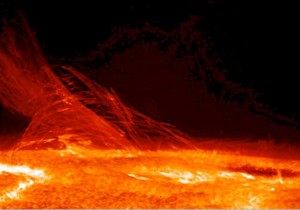5 January 2015
Measuring the temperature of solar winds
Posted by Nanci Bompey
By Kim Smuga-Otto

The sun spews forth super-heated, charged particles, collectively called plasma, that fly out into space. New research calculates the temperatures of the solar winds traveling at speeds greater than the speed of sound.
Credit: NASA
The sun spews forth super-heated, charged particles, collectively called plasma, that fly out into the vacuum of space at speeds of 200 to 400 miles per second (300 to 700 kilometers per second). These waves of plasma make up the solar winds that spread across our solar system.
Traveling across freezing space should suck all the heat from the plasma by the time it nears Earth, but the solar waves detected near our planet are still hot. Scientists think something is happening within the plasma to generate heat.
Astrophysicist Anthony Case of the Harvard-Smithsonian Center for Astrophysics calculated the temperatures of the solar winds traveling at different supersonic speeds, or speeds greater than the speed of sound. At a poster presentation at the American Geophysical Union’s Fall Meeting in San Francisco last month, Case showed it wasn’t simply that the faster wind contained hotter plasma, but that the speed-temperature relationship depended on whether the ions were traveling faster than the speed of sound. At these speeds the physics of the plasma changes because the ions at the front of the plasma wave are traveling too fast to be affected by the ions at the tail of the wave.
This supports a 2006 theory by astrophysicist William Matthaeus of the University of Delaware. He proposed that it was the interactions between the waves within the traveling plasma that created this extra heat.
The interactions are similar to throwing a rock into a stream. At first there is just a single large wave with all the water molecules moving up and down together. This single wave decomposes into multiple smaller waves. These small waves expand outward while the stream carries all the waves downstream. The overall movement of the stream determines how many times the small waves bump together, and it’s the bumping of these waves and the particles within them that creates the heat.
Case’s measurements came from the WIND spacecraft, a 20-year-old satellite outfitted with two Faraday Cups. These instruments catch the charged ions in the solar wind’s plasma and measure the resulting current to estimate the number of ions at various speeds. The speeds of all the captured ions can be averaged to calculate the temperature of the plasma.
The problem with WIND is its location. It’s only 1 percent closer to the sun than the Earth itself. Different solar winds are mixed together by the time they reach the satellite. Slower winds are overtaken by the faster winds and it’s difficult to separate them.
A solution to this problem will come in 2024 when the Solar Probe Plus spacecraft comes within 4.6 million miles (7.5 million kilometers) of the sun. It will be outfitted with a Faraday Cup, partly designed by Case, which will be able to withstand the 2,700 degrees Fahrenheit (1,500 degrees Celsius) heat from the sun.
“We’re just going to go there and measure these things,”said Case. The new spacecraft will allow them to know that the ions the Faraday Cup captures are from different solar winds.
There is another advantage to having a satellite so close to the sun. It is in this region that the solar winds heat up, from about 10,000 degrees Fahrenheit (6000 degrees Celsius) to more than 3.6 million degrees Fahrenheit (2 million degrees Celsius). At this time, their speed also increases and some winds will be accelerated past the speed of sound. Case hopes the Faraday Cup will be able to capture plasma ions in this transition. Knowing the supersonic speed and temperature of the plasma will either strengthen Matthaeus’s theory or cause scientists to re-evaluate how they think plasma generates heat.
— Kim Smuga-Otto is a science communication graduate student at UC Santa Cruz.


 GeoSpace is a blog on Earth and space science, managed by AGU’s Public Information staff. The blog features posts by AGU writers and guest contributors on all sorts of relevant science topics, but with a focus on new research and geo and space sciences-related stories that are currently in the news.
GeoSpace is a blog on Earth and space science, managed by AGU’s Public Information staff. The blog features posts by AGU writers and guest contributors on all sorts of relevant science topics, but with a focus on new research and geo and space sciences-related stories that are currently in the news.